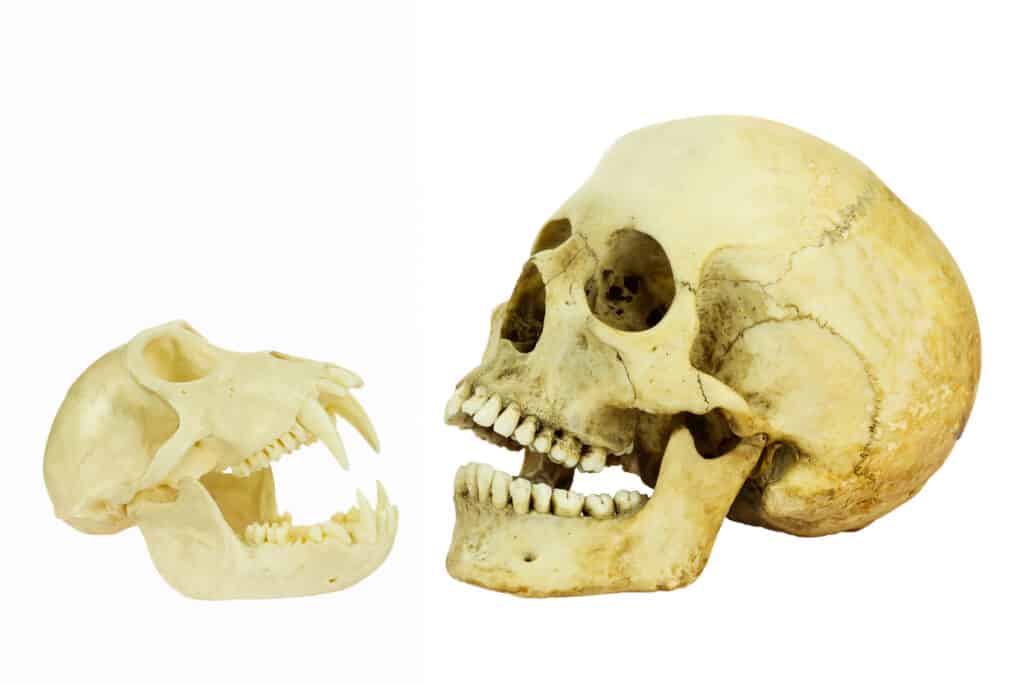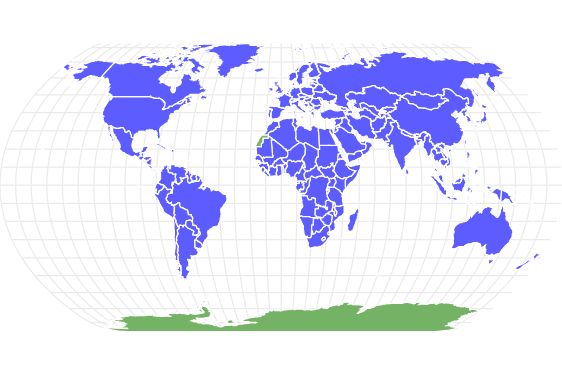Human
Homo Sapiens Sapiens
Thought to have orignated 200,000 years ago!
Advertisement
Human Scientific Classification
- Kingdom
- Animalia
- Phylum
- Chordata
- Class
- Mammalia
- Order
- Primates
- Family
- Hominidae
- Genus
- Homo
- Scientific Name
- Homo Sapiens Sapiens
Read our Complete Guide to Classification of Animals.
Human Conservation Status
Human Facts
- Main Prey
- Vegetables, Fruit, Fish
- Habitat
- Worldwide based near rivers
- Predators
- Bears, Lion, Tiger
- Diet
- Omnivore
- Average Litter Size
- 1
Humans are the only surviving species of the genus Homo.
Humans are in a class by themselves. We’re the only surviving species of the genus Homo, and as far as scientists and scholars can determine from current data, we enjoy higher cognitive function than every other animal.
But don’t confuse intelligence with rectitude. We’re also the most destructive species on Earth, and scientists caution that a failure to adjust our lifestyles may irrevocably harm the planet.
Ten Fascinating Facts About Humans

Anthropologists estimate that humans began to develop language, music, and other cultural universals 300,000 years ago.
©Billion Photos/Shutterstock.com
- Chimpanzees, gorillas, and bonobos are human’s closest living relatives. DNA sequencing for chimps and humans is between 95 and 99 percent identical.
- The evolutionary split date between humans and apes happened about four to eight million years ago.
- Anthropologists estimate that humans began to develop language, music, and other cultural universals 300,000 years ago.
- Until about 12,000 years ago, all humans lived as hunter-gatherers.
- About 7.5 billion humans currently occupy Earth.
- The human population has exploded over the past two centuries. It grew from one billion in 1800 to over seven billion in 2020.
- Human hair grows about six inches per year on average. The largest human ever reached a height of 8 feet 11 inches and had size 36 shoes!
- The human nose can detect one trillion smells.
- Human belly buttons grow special hairs to trap lint.
- Human feet are one of the most ticklish parts of the body.
You can check out more incredible facts about humans.
Evolution and Origins of Humans

Humans belong to the genus
Homo
and are believed to have evolved from a common ancestor with chimpanzees and bonobos.
©Ben Schonewille/Shutterstock.com
Humans belong to the genus Homo and are believed to have evolved from a common ancestor with chimpanzees and bonobos, with the split occurring around 6-7 million years ago.
The exact evolutionary path and origins of the genus Homo are still the subject of ongoing research and debate, but it is widely accepted that early members of the genus, such as Homo habilis, evolved in Africa and eventually gave rise to Homo erectus. This species then spread out of Africa around 1.8 million years ago and eventually evolved into Homo sapiens, the species to which modern humans belong, around 300,000 years ago.
In fact, humans belong to the primate order, which also includes other mammals such as monkeys, apes, and lemurs. Within this order, humans belong to the family Hominidae, which includes great apes such as gorillas, chimpanzees, and orangutans.
Additionally, there are three lower classifications of humans:
- Balangoda Man
- Herto Man
- Homo sapiens
The genus Homo, to which modern humans belong, is thought to have first appeared around 2.8 million years ago in Africa, with the earliest known member being Homo habilis. This early human species had a cranial capacity slightly larger than that of chimpanzees and were able to make and use stone tools.
Scientific Name

The scientific name for humans is “homo sapiens.” Coined by the father of taxonomy, Carl Linnaeus, both words derive from Latin, with Homo meaning “earthly being” and sapiens meaning “wise.”
©iStock.com/Daria Kulkova
The scientific name for humans is “homo sapiens.” Coined by the father of taxonomy, Carl Linnaeus, both words derive from Latin, with Homo meaning “earthly being” and sapiens meaning “wise.” In other words, homo sapiens translates to “wise man.” Note that the word is “sapiens,” not “sapien,” which is a common mistake.
Colloquially, the word “human” didn’t enter the English language until the 16th century. It started its linguistic life as an adjective from the Old French word “humain,” meaning compassionate or kindhearted.
Appearance and Behavior

Humans are one of the few species — though not the only — that qualify as bipedal, meaning we walk on two limbs.
©restyler/Shutterstock.com
Humans are one of the few species — though not the only — that qualify as bipedal, meaning we walk on two limbs.
The worldwide average height for adult males is 5 foot 7.5 inches, with a weight of 154 to 183 pounds. Females are slightly smaller, averaging 5 feet 2 inches in height and 119 to 141 pounds in weight. These figures vary from continent to continent, and country to country, because the environment affects human size.
Interestingly, humans change heights over the course of a single day. We’re all slightly taller in the morning because our cartilage compresses during the day.
Human beings may not appear to sport as much hair as the average ape, but we have more hair follicles than our chimp and gorilla cousins. We also have way more sweat glands — 2 million to be precise. Out of the primates, humans have the smallest teeth, and we’re the only species to sport chins.
The tallest human to ever live was Robert Pershing Wadlow. The Illinoisan stood 8 feet 11.1 inches tall and weighed 490 pounds. An infection inflicted by his stabilizing braces caused Wadlow’s death at the young age of 22. The tallest person alive today is Sultan Kösen, who measures 8 feet 2.8 inches and works as a farmer.
The shortest person to ever live was Chandra Bahadur Dangi. The Nepali stood 1 foot 9.5 inches tall and weighed 32 pounds. Dangi lived to the ripe old age of 75 and died of natural causes, likely pneumonia. The shortest person alive today is Jyoti Kisange Amge of India, who measures 2 feet 1.25 inches and works as an actress and chef.
The heaviest person to ever live was Jon Brower Minnoch. The Washingtonian tipped the scales at 1,400 pounds and stood 6 feet 1 inch tall. He died of complications caused by obesity at the age of 41. The heaviest person alive today is Khalid bin Mohsen Shaari of Saudi Arabia, who weighs 1,340 pounds.
Habitat
Humans are highly adaptable and have permanently colonized six of the seven continents. We can survive in both arctic and equatorial environments — and everything in between! Currently, 61 percent of humans live in Asia, 14 percent in the Americas, 14 percent in Africa, 11 percent in Europe, and .5 percent in Oceania.
Diet
Human beings are omnivores. We can digest meat, fish, vegetables, fruit, and dairy. For cultural and ethical reasons, however, about 8 percent of the world’s population chooses to eat fruits, vegetables, and dairy only. They’re called vegetarians. Of that 8 percent, about .5 percent also shun dairy. They’re called vegans.
Though people can eat all types of food, they can’t eat every food. Some fungi and plants are deadly to humans, like death cap mushrooms and hemlock.
Predators and Threats
Thanks to man-made weaponry, humans are at the top of the food and predatory chain. However, without weapons, several animals successfully prey on humans, including lions, tigers, bears, and crocodiles. Other animals, like coyotes, sharks, piranhas, dingoes, and rat swarms have killed humans in the past, but the low occurrences of such incidents don’t amount to predatory behavior.
Find out about more dangerous animals that are even more dangerous than sharks.
Reproduction, Babies, and Lifespan
Humans mate throughout the year, but cultural traditions significantly impact how, when, where, and even why. Unlike other animals, many humans mate for pleasure only, and not just for reproduction. However, some groups of people only mate with the hope or intention of creating more humans.
Males and females reach sexual maturity between the ages of 12 and 15 but typically choose not to have babies until they’re in their late 20s or early 30s.
Female humans gestate for about nine months, and childbirth is exceptionally dangerous because of our bipedalism. Since we walk on two feet, our birth canals are more narrow, making the journey arduous. As a result, human babies are more vulnerable than any other mammal in the first several months of their lives. At birth, they weigh between 7 and 9 pounds and are about 20 to 24 inches tall.
The average lifespan for humans is 60 to 80 years, depending on the region. The oldest person to ever live was Jeanne Calment, who was born in 1875 and lived to 1997, 122 years and 164 days. Learn about the oldest living animals on earth here.
Population
Over 8 Billion people live on the planet, and the International Union for the Conservation of Nature puts us in the Least Concern conservation status grouping.
Humans are one of the most populous species on Earth and the most populous mammal. But if domestic chickens were ever to rise up, they would outnumber us by about three to one!
More on Humans
- What’s the Largest Baby Ever Born?
- What’s the Largest Cell In the Human Body?
- What’s the Largest Cranial Nerve in the Human Body?
Human FAQs (Frequently Asked Questions)
Are Humans Carnivores, Herbivores, or Omnivores?
Humans are omnivores, meaning they can eat plants, meat, and fish. However, some humans choose to be herbivores in practice.
How Many Bones Are in the Human Body?
There are 270 bones in the human body at birth. By adulthood, only 206 remain because some fuse together during the growth phase.
How Much Blood is in the Human Body?
About 7 to 8 percent of the human body is comprised of blood, which calculates to about 1.2 to 1.5 gallons (10 units).
What Defines a Human?
Believe it or not, scientists and scholars cannot come to a consensus as to what makes a human … human. Some say our ability to communicate with language and significantly manipulate physical properties sets us apart. Others, however, argue that we can’t determine if other species communicate in a way that we simply don’t understand.
How Fast Can a Human Run?
The average human can run 6.5 to 8.5 miles an hour. The fastest clocked running speed for a human is 28 miles per hour. Currently, the fastest human on the planet is Olympic sprinter Usain Bolt, who runs at about 27.3 miles per hour.
What Kingdom do Humans belong to?
Humans belong to the Kingdom Animalia.
What phylum do Humans belong to?
Humans belong to the phylum Chordata.
What class do Humans belong to?
Humans belong to the class Mammalia.
What family do Humans belong to?
Humans belong to the family Hominidae.
What order do Humans belong to?
Humans belong to the order Primates.
What genus do Humans belong to?
Humans belong to the genus Homo.
What type of covering do Humans have?
Humans are covered in Smooth skin.
In what type of habitat do Humans live?
Humans live worldwide near rivers.
What do Humans eat?
Humans eat vegetables, fruit, and fish.
What are some predators of Humans?
Predators of Humans include bears, lions, and tigers.
What is an interesting fact about Humans?
Humans are thought to have originated 200,000 years ago!
What is the scientific name for the Human?
The scientific name for the Human is Homo Sapiens.
What is the lifespan of a Human?
Humans can live for 60 to 80 years.
Who would win a fight between a chimpanzee and a human?
A chimp would win a fight against a human. Although chimps and humans are carnivores with formidable fighting abilities, a chimp is far more aggressive and violent than a person.
Who would win in a fight between a human and a kangaroo?
A kangaroo would win a fight against a human being.
What is the difference between Neanderthal skull and human skull?
The main differences between a Neanderthal skull and a human skull include their shape and size. Although they were humans like us, Neanderthals belonged to a separate species known as Homo neanderthalensis.
Are redheads going extinct?
No, redheads are not going extinct, despite an article that suggested otherwise.
A 2007 study by unnamed geneticists claimed red hair would die out in the near future, but the majority of scientists dispute this.
Thank you for reading! Have some feedback for us? Contact the AZ Animals editorial team.
Sources
- David Burnie, Dorling Kindersley (2011) Animal, The Definitive Visual Guide To The World's Wildlife
- Tom Jackson, Lorenz Books (2007) The World Encyclopedia Of Animals
- David Burnie, Kingfisher (2011) The Kingfisher Animal Encyclopedia
- Richard Mackay, University of California Press (2009) The Atlas Of Endangered Species
- David Burnie, Dorling Kindersley (2008) Illustrated Encyclopedia Of Animals
- Dorling Kindersley (2006) Dorling Kindersley Encyclopedia Of Animals
- David W. Macdonald, Oxford University Press (2010) The Encyclopedia Of Mammals

















